Module 9: Parietal Lobes and Attention
1/40
There's no tags or description
Looks like no tags are added yet.
Name | Mastery | Learn | Test | Matching | Spaced |
|---|
No study sessions yet.
41 Terms
Anterior Parietal Lobe
Contains primary somatosensory cortex for sensory processing.
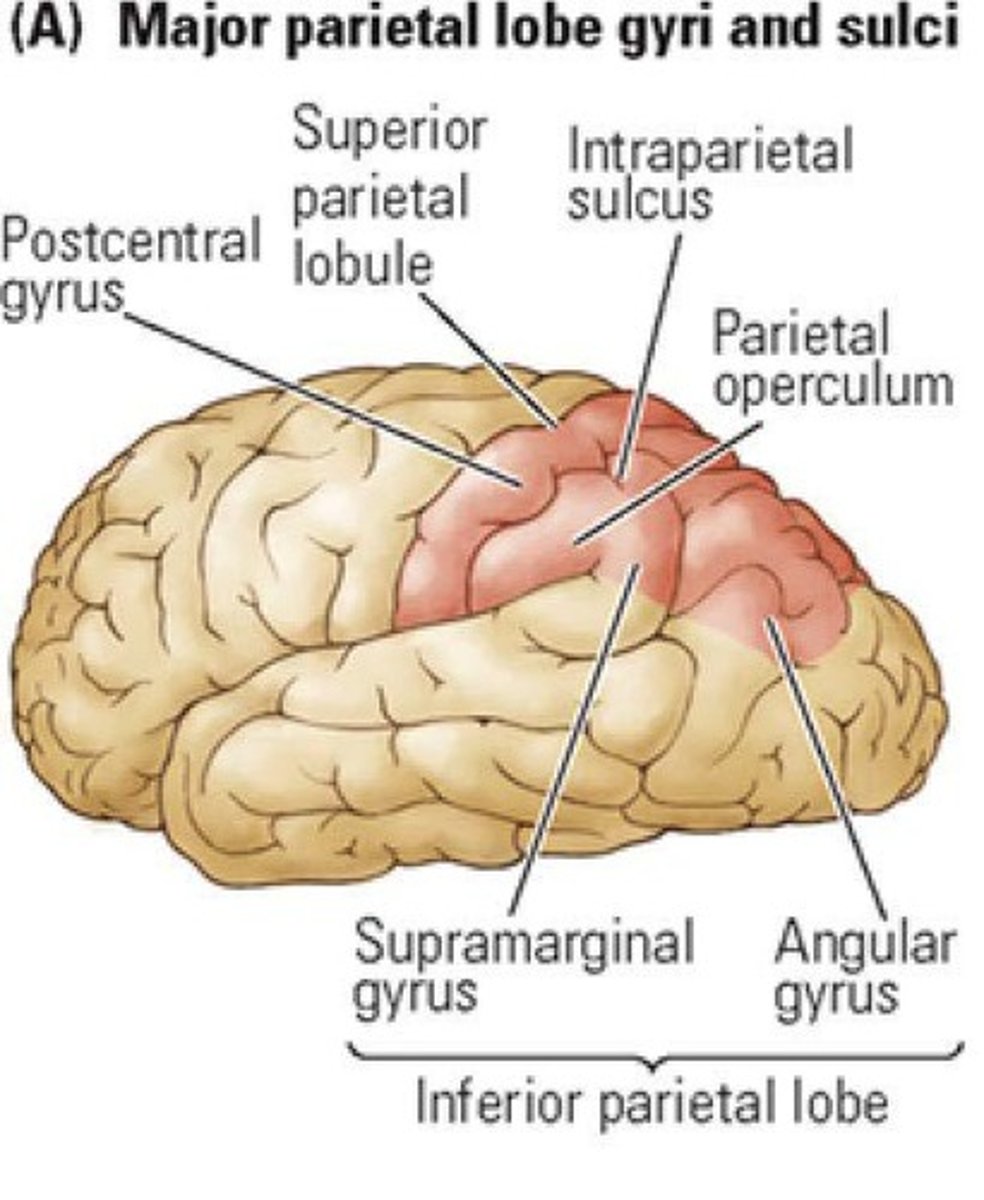
Posterior Parietal Lobe
Involved in the association cortex for spatial awareness.
- "where" pathway (spatial information) Dorsal Stream
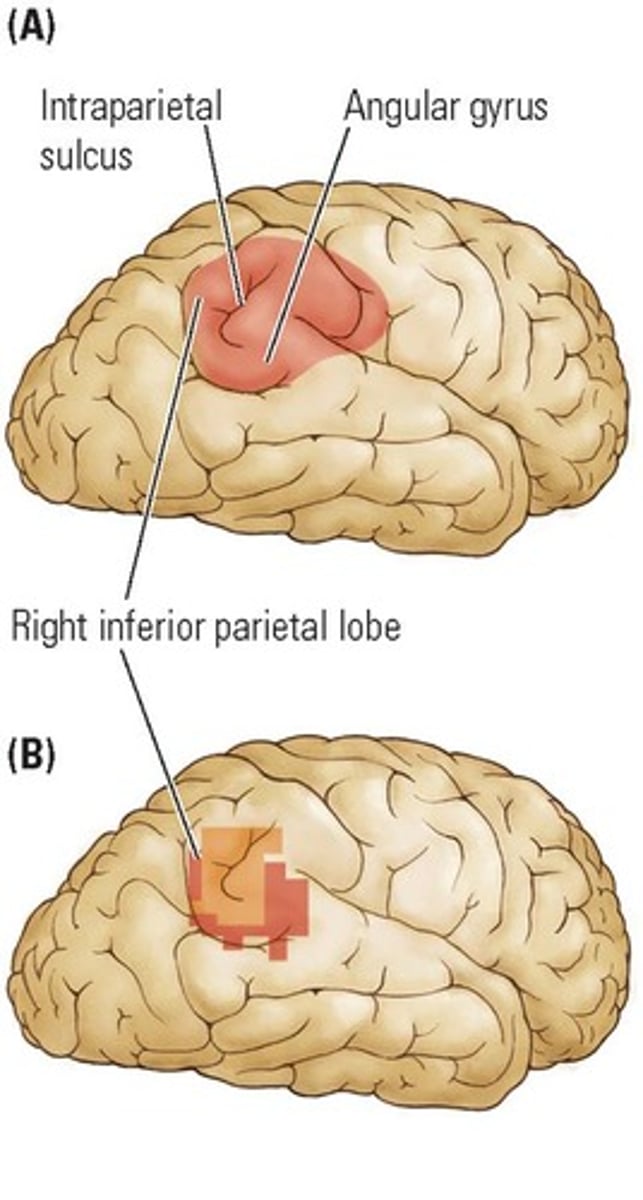
What are the behavioral uses of spatial information? (5 total)
1) Movement guidance (e.g., reaching, grasping)
- object recognition
2) Sensorimotor transformation
- body now to body future
- engages the parietal lobe in this motor planning process
3) Spatial navigation
- temporal lobe
- relays info. to the parietal lobe region
4) math (can be visually organized spatially)
5) Language (syntax)
Movement Guidance
Facilitates reaching and grasping actions.
Sensorimotor Transformation
Converts body position into movement plans.
Body Now to Body Future
Translates current body position to future actions.
Spatial Navigation
Ability to move through and understand space.
Dyscalculia
Difficulty with mathematical tasks and concepts.
Astereognosis
Inability to recognize objects by touch

Asomatognosia
Loss of awareness of body part ownership.
- absence or loss of body sense
- The posterior parietal has some area that allows us to understand our body as our own
- can show person one of their body parts and thy will be certain it is not theirs
What is an example of Asomatognosia?
- The patient began complaining that the nurse was playing a trick on him by putting a cadaver leg in his bed
- Turns out leg was his own
- can show a person one of their body parts and they will be certain it is not theirs
Apraxia
Disruption in planning and executing movements
- problems with motor sequencing and copying
- occurs in left hemisphere
Optic Ataxia
Difficulty in visually-guided reaching movements.
- bilateral
-damage in where/how pathway
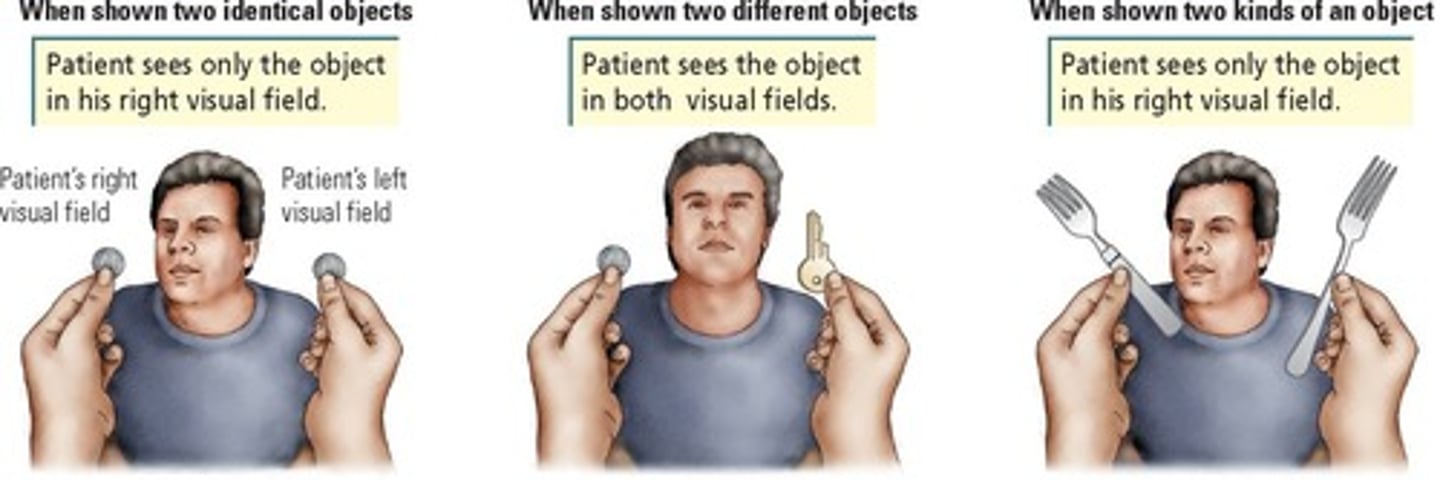
Simultaneous Extinction
Failure to perceive stimuli on one side when both sides are stimulated.
- typically left side neglect (right hemispheric damage)
- observed when the same objects are presented in each visual field
What does feature dependent mean? (e.g., when items are different)
What does it showcase?
When objects are different (e.g., key and spoon) there tends to be a detection of items on both sides when items are presented simultaneously
This showcased the awareness is there but the conscious perception is not!
What happens when you draw attention to the left side with someone with right hemineglect?
Line bisection task?
- Ringing a bell or shining a light on left will help draw attention to the left side
- Spatial cue
- in a line bisection task where the person draws the horizontal line off center to the right when asked to draw midline, you can train them to draw attention to the left by ringing bell or flashing light to bring attention to the side they are neglecting
Explain study showcasing right hemi. damage and how it causes simultaneous extinction.
- left. hemi seems to engage just the right side of space
- right hemi. has bimodal representation both for left and right sides of space
- damage to right hemisphere will prevent any recognition of left side of space as left hemisphere is not able to compensate (NOT BIMODAL)
How does attention play a role when it comes to recognition of visual fields?
1st Test: two identical objects shown in the right and left visual fields --> object only seen in the right side of space
- The brain is not drawing attention to both
2nd Test: shown two different objects in the right and left visual fields --> patient sees different objects in both
- attention going to both
3rd Test: patient shown two types of the SAME object --> patient only reports object in right visual field
- objects are similar but not the same (patient will still ignore object on the left side)
Contralateral Neglect
What happens when you knock out right hemisphere functioning?
Inattention to one side of space due to brain damage.
- lesion most often in right inferior parietal lobe
We lose the ability for left field representation as the left hemi. cannot compensate as it is contralateral (left hemi --> right field representation ONLY)
Attention
Cognitive process of focusing on specific stimuli.
Vigilance
- Paying attention to something
- sustained attention for completing a task (e.g., watching a lecture)
How can the amount of attention needed to complete a task change?
It can change depending on what is occurring (effort and resource capacity)
- mental workload and task difficulty
Selective Attention
Focusing on one stimulus while ignoring others.
Divided Attention
Allocating attention to multiple tasks simultaneously. (e.g., texting and driving)
What is Posner's Attention Switching Paradigm?
What does it look at?
What are the results?
What areas of the brain are involved? (three areas)
Experimental method to study attention shifts
- demonstrates that we can prime and change our attention to a side
- It looks at covert attention, not directly asking a person to direct their attention one way
- showcase a valid cue and an invalid cue (valid cue chown 80% of time)
RESULTS:
- The reaction time for the valid cue is quicker than the reaction time for the invalid cue, as it requires a switch in attention (disengage, move, re-engage)
The areas of the brain involved are likely the parietal lobe (allocating attention), superior colliculus (detection of where things are in space), and the thalamus (rerouting info. between both hemispheres).
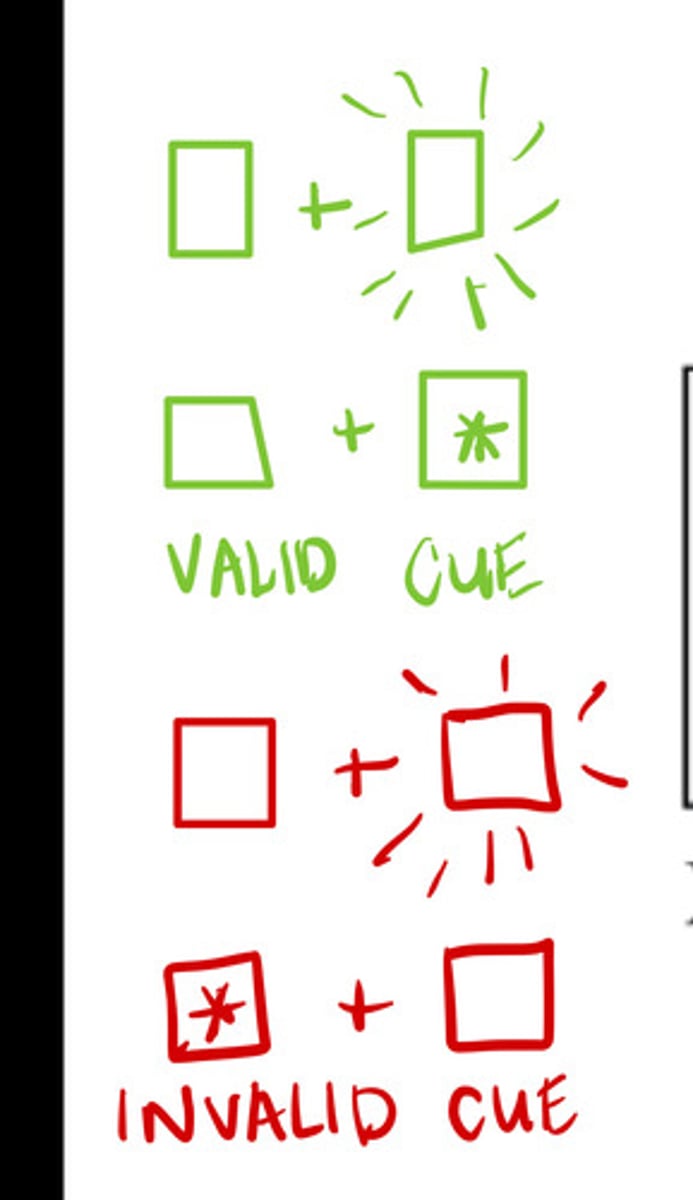
Covert Attention
Shifting focus without moving eyes.
Valid Cue
Cue (light flashing) and astricts (*) on same side
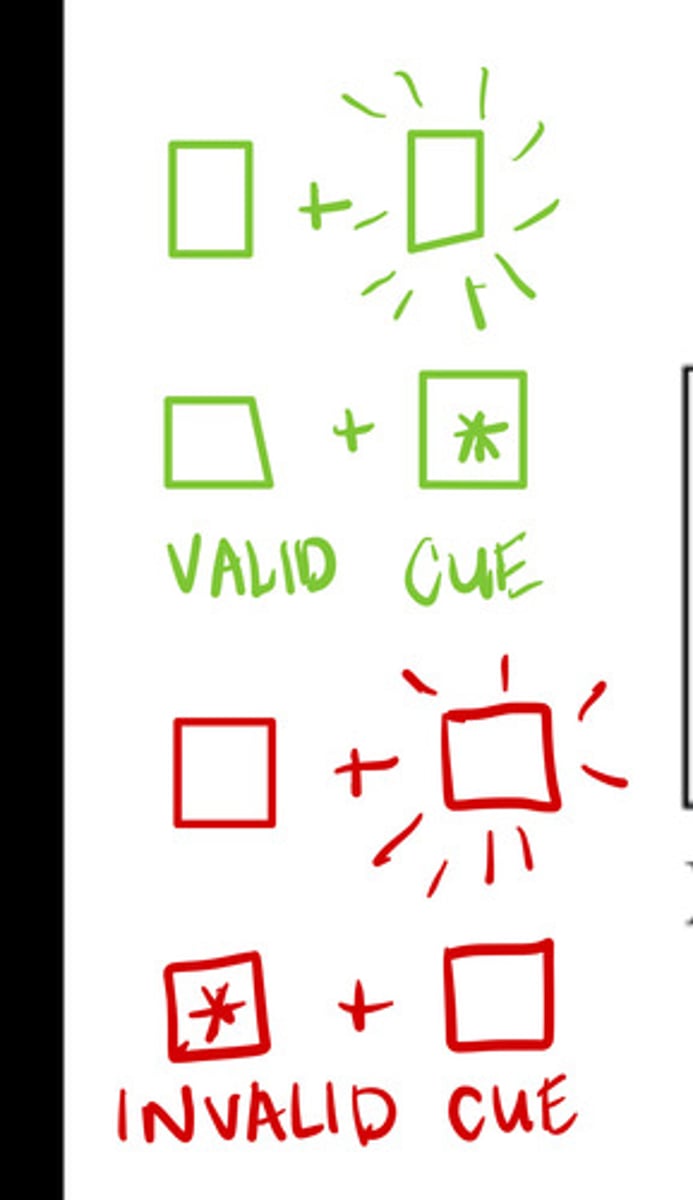
Invalid Cue
Cue (light flashing) and astrics (*) on DIFFERENT sides
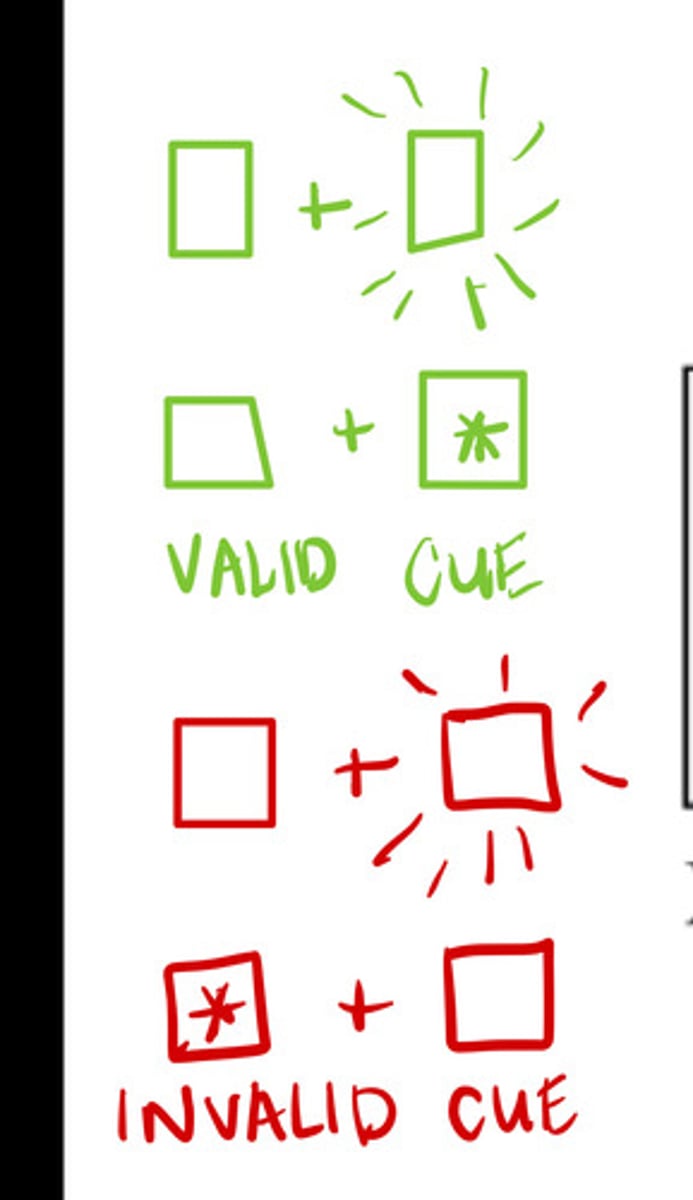
DLPFC Recruitment (study)
- Dorsal Prefrontal Cortex
- Involvement of the prefrontal cortex in divided attention tasks
- fMRI data
- Geometric shapes and melodies were shown to participants
- Visual focus, memory focus OR both shown at the same time (must divide attention)
RESULTS:
- When focused on both stimuli to answer questions later, we get activation in the DLPFC

Hemi-inattention
Inability to attend to stimuli on one side.
Prism Effect
What is helping with the compensation?
- Prism goggles help Patient A (even after goggles are off) to recognize components of image in left visual field
- Control Patient B shows complete neglect of left visual field (as neutral goggles do not help with compensation
What is helping with the compensation?
Goggles help other regions in the brain (like the cerebellum) to compensate for the region of damage they have (*does not draw full attention but it helps with continual exposure)
What is the Bisiach and Luzzatti(1978) study?

Balint's Syndrome
Condition characterized by simultagnosia, optic ataxia, and oculomotor apraxia.
Simultagnosia
Inability to perceive multiple objects at once.
What are the three symptoms of Balint's Syndrome?
1) Simultagnosia
2) Optic Ataxia
3) Oculomotor apraxia
Oculomotor Apraxia
Difficulty in directing eye movements to objects.
- deficit in optic tracking
- particular to eye movements
- eyes become fixed in a specific location
- combination of left and right parietal lobe damage
Peripersonal Space
The space immediately surrounding the body, important for interaction.
- If you hover your hand over a body part, certain cells will fire even if they aren't being touched (visual stimulation vs. tactile)
Extra-personal Space
Space beyond immediate reach, less relevant to body interaction.
Adaptive Rehabilitation
Using patient strengths to improve functional abilities.
Visual Memory
Ability to remember visual information over time.
Neurophysiological Studies
Research examining brain functions related to spatial awareness.